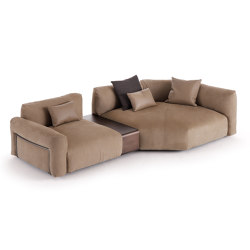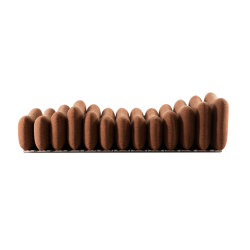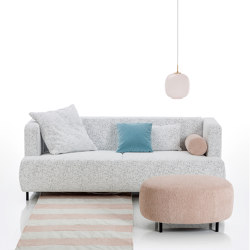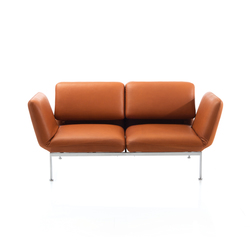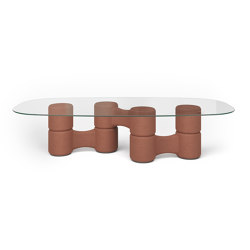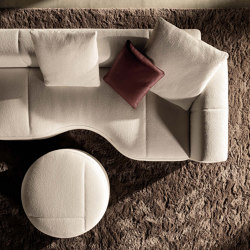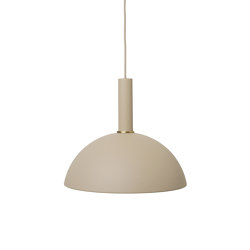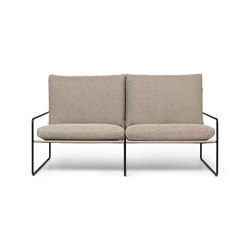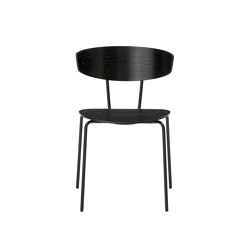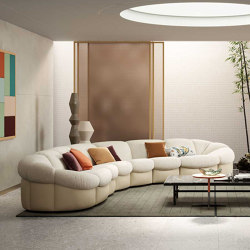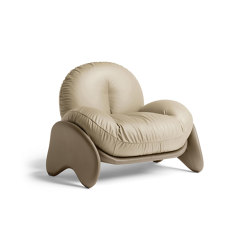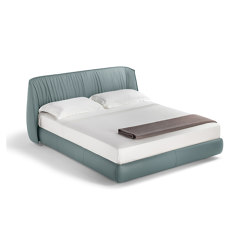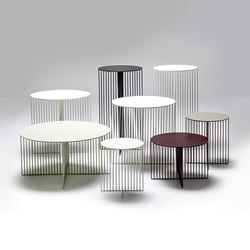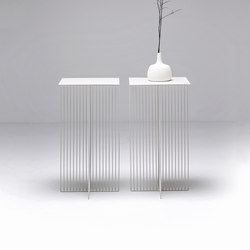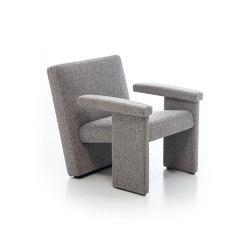Sobre Rietveld by Rietveld
DESCUBRE MáS SOBRE RIETVELD BY RIETVELD
Rietveld by Rietveld.
Under this meaningful name, two of Gerrit Rietveld’s descendents will bring reproductions from Rietveld’s comprehensive oeuvre of furniture on the market. It is an initiative of Egbert Rietveld (1961) – one of Rietveld’s grandsons – and great-grandson Ries Seijler (1962). The two second cousins want ‘to show the world that Rietveld is more than just the Red-Blue or the Zigzag chair’. On 25 June 2004, exactly 40 years after the death of Gerrit Rietveld, they started their company Rietveld by Rietveld. The first five models will be available across the world from early 2005.
Gerrit Thomas Rietveld (1888 -1964): furniture maker, designer, architect. Even now, he is usually associated with one chair from 1918 and one house from 1924: his Red-Blue chair and the Rietveld-Schröder house. But Rietveld left behind an oeuvre which is even more comprehensive: no fewer than 215 furniture designs, 232 designs for buildings and 240 other designs. Sometimes it concerns tangible furniture, single copies or prototypes, while only sketches or drafts are available for other models. Thanks to Rietveld by Rietveld, part of those furniture designs will be available to buy soon after all.
Reproduction and interpretation
Rietveld by Rietveld starts with a range of five models: the Military chair, the Military table, the Military stool, the Berlin chair and the Steltman chair. Egbert Rietveld: “We will reproduce the furniture in the spirit of my grandfather and will replicate everything as closely as possible. We will however make use of modern day technologies if that enhances the quality of the furniture. So in that sense we’re not purists. Where possible, we will for instance spray instead of ‘brush’; after all, these days my grandfather would have done the same. We will not put a solid coat of varnish on it though, because in many designs the wood grain shows and such details are very important to the overall picture.”
Ries Seijler continues: “Rietveld always tried to produce things in the easiest way possible. The fact that the Panton Chair comes out of a machine with one push of a button for instance, he would have found fantastic. But with the techniques and materials of those days, he wasn’t able to do what he wanted. He had to nail down the seat of the Military chair, because polyether glue simply wasn’t available then. Apart from the fact that we will improve the construction and apply different glue joints here and there, at times different materials are also required. Rietveld once designed a Berlin chair with a beech leg for example, but that hasn’t resisted the ravages of time very well. So we will do it differently. We will also use stainless steel carriage bolts instead of nickel or iron ones. We make reproductions, but we will also make interpretations and we will always make choices which will not concede to quality. Look, we could make a Perspex Military chair. But where do you draw the line? In order to stay as pure as possible, we will therefore first submit any changes to the family and a recommending committee, which includes Cees Dam and Richard Hutten among others.”
So many chairs, so many designs
The two second cousins are proud of the fact that the first prototypes were ready within a couple of months. “Particularly when you take into account that we encountered more problems than we could have anticipated, especially when it comes to measurements”, says Egbert Rietveld. “Of course we visited various archives and museums first. It was funny to see how, on hearing my surname, doors suddenly literally opened themselves, and I was able to measure the models to the millimetre. But then we noticed something: much of the furniture in museums has warped extensively over the years. The more models we measured and the more drafts we found – both from museums and Rietveld himself – the more it became clear that there were several versions of a certain model. Looking back that’s logical, bearing in mind that Rietveld often worked on commission and everything was made by hand. The saying ‘you enjoy it as it was made’, spoken with a Utrecht accent, is still frequently coined in the family. Nevertheless, there is reasonable leeway measurement-wise; there is a margin to safely interpret Rietveld and we take that liberty.”
Money
“We realise some people will question our good intentions. In a negative sense, you could call it commercially exploiting Rietveld”, Egbert Rietveld continues. “But that has definitely not been the basic principle. We want to show the world that Rietveld is much more than just the Red-Blue or the Zigzag chair. Not with expensive, limited editions in gold boxes with ribbons, we want to spread out our range, worldwide. The fact that it does come with a price tag is obvious from the quality and status of brand furniture. Additionally, a piece of furniture by Rietveld has historical added value. So like Cassina, we will put Rietveld in the top end of the market. In his time, Rietveld was a kind of Ikea avant-la-lettre, but nowadays he simply belongs to a higher level”. Ries Seijler: “Financially, we’ve only put money into it. With that we will enter into a similar contract with Stichting Beeldrecht (Dutch Visual Arts Rights Foundation) as they did with Cassina, including the royalty payments to the family. Thus, Rietveld by Rietveld deliberately has no privileged position in that respect either.”
The models produced by Cassina remain part of their ‘I Maestri’ range. They are the Red-Blue chair, the Zigzag chair, the Divan table (‘Schroeder’), the upholstered Armchair and Utrecht sofa.
Each year, Rietveld by Rietveld wants to add new designs to its range. “Famous ones, but also models not yet known to the world. Things Rietveld has drawn, but never produced”, says Ries Seijler. “To that end, we will collaborate with a Dutch manufacturer able to handle large quantities, with chair number 10 being exactly the same as chair number 1000. Because that is our aim: making Rietveld widely accessible instead of it just being a collector’s item for the happy few.”
Monique van Empel
Rietveld by Rietveld.
Under this meaningful name, two of Gerrit Rietveld’s descendents will bring reproductions from Rietveld’s comprehensive oeuvre of furniture on the market. It is an initiative of Egbert Rietveld (1961) – one of Rietveld’s grandsons – and great-grandson Ries Seijler (1962). The two second cousins want ‘to show the world that Rietveld is more than just the Red-Blue or the Zigzag chair’. On 25 June 2004, exactly 40 years after the death of Gerrit Rietveld, they started their company Rietveld by Rietveld. The first five models will be available across the world from early 2005.
Gerrit Thomas Rietveld (1888 -1964): furniture maker, designer, architect. Even now, he is usually associated with one chair from 1918 and one house from 1924: his Red-Blue chair and the Rietveld-Schröder house. But Rietveld left behind an oeuvre which is even more comprehensive: no fewer than 215 furniture designs, 232 designs for buildings and 240 other designs. Sometimes it concerns tangible furniture, single copies or prototypes, while only sketches or drafts are available for other models. Thanks to Rietveld by Rietveld, part of those furniture designs will be available to buy soon after all.
Reproduction and interpretation
Rietveld by Rietveld starts with a range of five models: the Military chair, the Military table, the Military stool, the Berlin chair and the Steltman chair. Egbert Rietveld: “We will reproduce the furniture in the spirit of my grandfather and will replicate everything as closely as possible. We will however make use of modern day technologies if that enhances the quality of the furniture. So in that sense we’re not purists. Where possible, we will for instance spray instead of ‘brush’; after all, these days my grandfather would have done the same. We will not put a solid coat of varnish on it though, because in many designs the wood grain shows and such details are very important to the overall picture.”
Ries Seijler continues: “Rietveld always tried to produce things in the easiest way possible. The fact that the Panton Chair comes out of a machine with one push of a button for instance, he would have found fantastic. But with the techniques and materials of those days, he wasn’t able to do what he wanted. He had to nail down the seat of the Military chair, because polyether glue simply wasn’t available then. Apart from the fact that we will improve the construction and apply different glue joints here and there, at times different materials are also required. Rietveld once designed a Berlin chair with a beech leg for example, but that hasn’t resisted the ravages of time very well. So we will do it differently. We will also use stainless steel carriage bolts instead of nickel or iron ones. We make reproductions, but we will also make interpretations and we will always make choices which will not concede to quality. Look, we could make a Perspex Military chair. But where do you draw the line? In order to stay as pure as possible, we will therefore first submit any changes to the family and a recommending committee, which includes Cees Dam and Richard Hutten among others.”
So many chairs, so many designs
The two second cousins are proud of the fact that the first prototypes were ready within a couple of months. “Particularly when you take into account that we encountered more problems than we could have anticipated, especially when it comes to measurements”, says Egbert Rietveld. “Of course we visited various archives and museums first. It was funny to see how, on hearing my surname, doors suddenly literally opened themselves, and I was able to measure the models to the millimetre. But then we noticed something: much of the furniture in museums has warped extensively over the years. The more models we measured and the more drafts we found – both from museums and Rietveld himself – the more it became clear that there were several versions of a certain model. Looking back that’s logical, bearing in mind that Rietveld often worked on commission and everything was made by hand. The saying ‘you enjoy it as it was made’, spoken with a Utrecht accent, is still frequently coined in the family. Nevertheless, there is reasonable leeway measurement-wise; there is a margin to safely interpret Rietveld and we take that liberty.”
Money
“We realise some people will question our good intentions. In a negative sense, you could call it commercially exploiting Rietveld”, Egbert Rietveld continues. “But that has definitely not been the basic principle. We want to show the world that Rietveld is much more than just the Red-Blue or the Zigzag chair. Not with expensive, limited editions in gold boxes with ribbons, we want to spread out our range, worldwide. The fact that it does come with a price tag is obvious from the quality and status of brand furniture. Additionally, a piece of furniture by Rietveld has historical added value. So like Cassina, we will put Rietveld in the top end of the market. In his time, Rietveld was a kind of Ikea avant-la-lettre, but nowadays he simply belongs to a higher level”. Ries Seijler: “Financially, we’ve only put money into it. With that we will enter into a similar contract with Stichting Beeldrecht (Dutch Visual Arts Rights Foundation) as they did with Cassina, including the royalty payments to the family. Thus, Rietveld by Rietveld deliberately has no privileged position in that respect either.”
The models produced by Cassina remain part of their ‘I Maestri’ range. They are the Red-Blue chair, the Zigzag chair, the Divan table (‘Schroeder’), the upholstered Armchair and Utrecht sofa.
Each year, Rietveld by Rietveld wants to add new designs to its range. “Famous ones, but also models not yet known to the world. Things Rietveld has drawn, but never produced”, says Ries Seijler. “To that end, we will collaborate with a Dutch manufacturer able to handle large quantities, with chair number 10 being exactly the same as chair number 1000. Because that is our aim: making Rietveld widely accessible instead of it just being a collector’s item for the happy few.”
Monique van Empel
DESCUBRE MáS SOBRE RIETVELD BY RIETVELD
